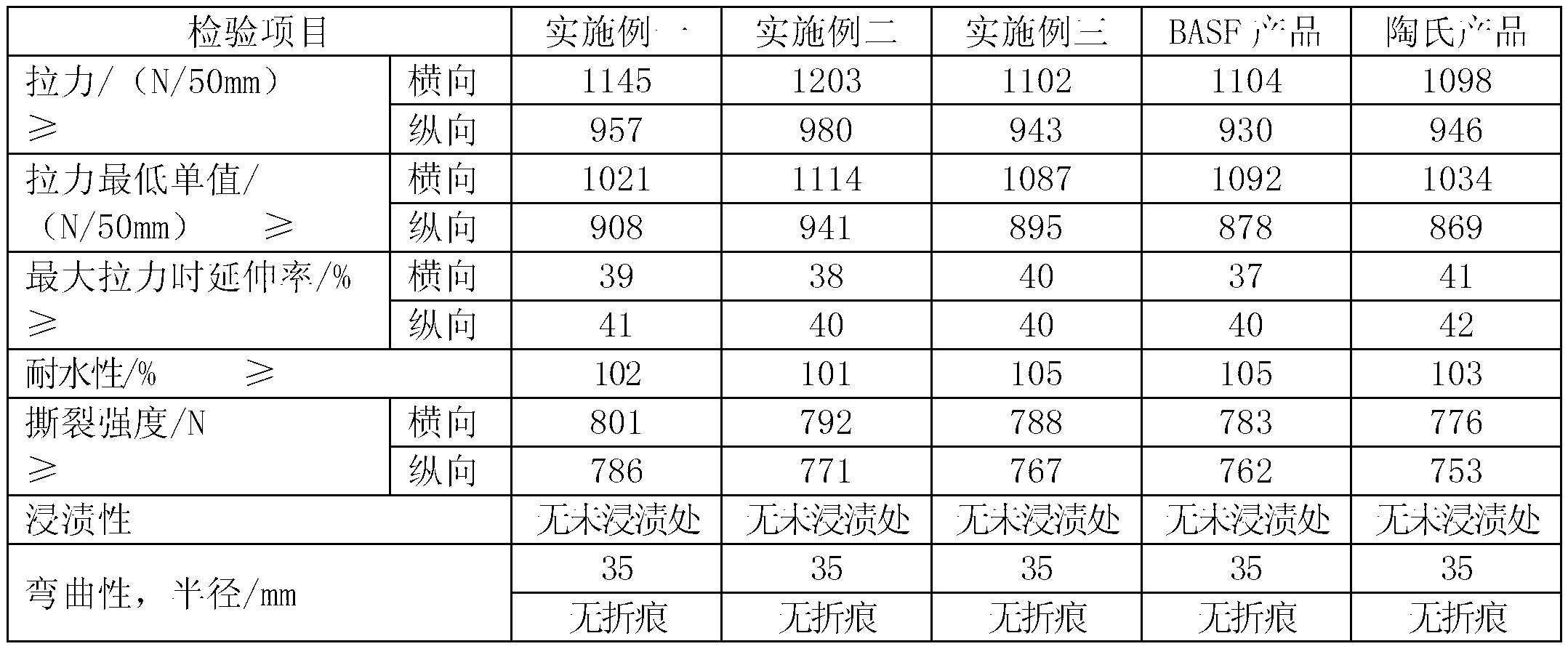Heat-stabilized acrylate adhesive used for waterproof coiled material blank base cloth, and preparation method thereof
A technology of acrylate and waterproof coiled material, applied in the direction of ester copolymer adhesive, adhesive type, etc., can solve the problems of affecting construction waterproofing effect, unqualified coiled material products, thermal deformation, etc., to improve thermal dimensional stability The effect of improving the crosslinking density and excellent performance
- Summary
- Abstract
- Description
- Claims
- Application Information
AI Technical Summary
Problems solved by technology
Method used
Image
Examples
Embodiment 1
[0030] ① Dissolve 0.8 g of sodium lauryl sulfate in 25 g of deionized water, add to an emulsification kettle, mix 2.5 g of nonylphenol polyoxyethylene ether (NP-40), 1.4 g of N-methylol acrylamide, and itaconic acid Add 0.5 g of monobutyl ester, 1.2 g of acetoacetoxyethyl methacrylate, 0.6 g of acrylic acid, 2 g of styrene, 26.3 g of butyl acrylate, and 5.2 g of ethyl acrylate into an emulsification kettle, stir and emulsify to prepare a pre-emulsion.
[0031] ③ Dissolve 0.6 g of ammonium persulfate in 6 g of deionized water to make an initiator solution for use.
[0032] ④ Add 27 grams of deionized water to the reactor, heat up to 85-95°C, add about 9.75 grams of pre-emulsion, which is about 15% of the total mass of the pre-emulsion prepared in step ①, to the reactor, and then add the initiator prepared in step ② 33% of the total mass of the solution was 2.2 grams, and the polymerization reaction was started.
[0033] ④ After 20 minutes, add the remaining emulsion prepared i...
Embodiment 2
[0036] ① Dissolve 0.7 g of sodium lauryl sulfate in 25 g of deionized water, add to an emulsification kettle, mix 2.8 g of nonylphenol polyoxyethylene ether (NP-40), 1.3 g of N-methylol acrylamide, and itaconic acid Add 0.5 grams of monobutyl ester, 1.3 grams of acetoacetoxy ethyl methacrylate, 0.5 grams of acrylic acid, 5 grams of styrene, 24.4 grams of butyl acrylate, and 4 grams of 2-ethylhexyl acrylate into the emulsification kettle, stir and emulsify, Make a pre-emulsion.
[0037] ② Dissolve 0.7 g of ammonium persulfate in 7 g of deionized water to make an initiator solution for use.
[0038] ③Add 27 grams of deionized water to the reactor, heat up to 85-95°C, add 13 grams of pre-emulsion of 20% of the total mass of the pre-emulsion prepared in step ① to the reactor, and then add the initiator solution prepared in step ② 40% of the total mass was 3.08 grams, and the polymerization reaction was started.
[0039] ④ After 20 minutes, add the remaining emulsion prepared in ...
Embodiment 3
[0042] ① Dissolve 0.6 g of sodium lauryl sulfate in 27 g of deionized water, add it to an emulsification kettle, add 3 g of nonylphenol polyoxyethylene ether (NP-40), 1.6 g of N-methylol acrylamide, and itaconic acid Add 0.5 grams of monobutyl ester, 1.2 grams of acetoacetoxy ethyl methacrylate, 0.6 grams of acrylic acid, 4 grams of styrene, 23.2 grams of butyl acrylate, and 6 grams of 2-ethylhexyl acrylate into the emulsification kettle, stir and emulsify, Make a pre-emulsion.
[0043] ② Dissolve 0.8 g of ammonium persulfate in 8 g of deionized water to prepare an initiator solution for use.
[0044] ③Add 23 grams of deionized water to the reactor, heat up to 85-95°C, add about 13.44 grams of pre-emulsion, which is about 20% of the total mass of the pre-emulsion prepared in step ①, to the reactor, and then add the initiator prepared in step ② 40% of the total mass of the agent solution was 3.52 grams, and the polymerization reaction was started.
[0045] ④ After 20 minutes,...
PUM
 Login to View More
Login to View More Abstract
Description
Claims
Application Information
 Login to View More
Login to View More - R&D
- Intellectual Property
- Life Sciences
- Materials
- Tech Scout
- Unparalleled Data Quality
- Higher Quality Content
- 60% Fewer Hallucinations
Browse by: Latest US Patents, China's latest patents, Technical Efficacy Thesaurus, Application Domain, Technology Topic, Popular Technical Reports.
© 2025 PatSnap. All rights reserved.Legal|Privacy policy|Modern Slavery Act Transparency Statement|Sitemap|About US| Contact US: help@patsnap.com


